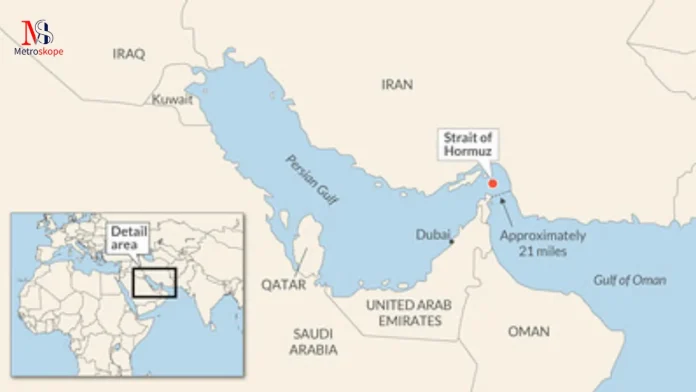June 13–22, 2025: U.S. bombs hit Iran’s nuclear sites (Natanz, Fordow, Isfahan), in coordination with Israeli airstrikes—marking the biggest Western strike since 1979.
June 22: Iran’s parliament approved a non-binding motion to close the Strait of Hormuz, a critical shipping chokepoint through which ~20% of global oil and 25% of LNG flows.
Tehran also vowed to retaliate—via missile launches, cyber tactics, proxy engagements, and possibly exiting nuclear treaties.
Why the Strait of Hormuz Matters
- It connects the Persian Gulf to the Gulf of Oman—at its narrowest, just 33 km wide, with shipping lanes only 3 km.
- Routinely carries 17.8–20.8 million barrels of oil/day—amounting to around 20% of global oil consumption—and 20% of LNG.
- Alternatives exist (e.g., pipelines from Saudi to Red Sea, UAE pipeline to Oman) but are limited and costlier .
Iran’s Retaliation Toolkit
Iran’s strategic options—outlined by Financial Times, AP etc.—include:
- Mining the Strait: Using mines and limpet bombs to obstruct tankers.
- Missile/Drone Strikes: Targeting shipping lanes or U.S./Israeli bases, possibly via proxies like Houthis or Iraqi militias.
- Electronic Warfare/Cyberattacks: Targeting navigation systems, port operations.
- Accelerating Nuclear Program: Exiting treaties or resuming uranium enrichment to increase deterrence.
Any blockage would require asymmetric “A2/AD” tactics: fast boats, anti-ship missiles, coastal defenses, mines—leveraging Iran’s geography
Global Impact: Brace for Boom (in Oil Prices)
- Prices have already surged: Brent ~USD 80–81 (+3.9–6%), WTI ~USD 77.
- A disruption could add $10+/barrel—which in turn could raise India’s oil import bill by $13–14 billion and widen its CAD by ~0.3% of GDP.
- The International Energy Agency warns prices could spiral well above current levels, straining global economies .
India’s Preparedness: Smooth Operator?
- Oil Minister Hardeep Singh Puri assured that India has diversified sources—less reliant on Hormuz, with strategic reserves covering several weeks.
- India has ramped up crude imports from Russia and the U.S., with Russia becoming the top supplier—using alternative sea routes via Suez or Cape of Good Hope.
- With Middle East oil accounting for <50% of India’s ~4.8 mbpd imports, the country seems insulated for now .
- PM Modi also engaged diplomatically—speaking with Iran’s President to quell tensions.
India has expected & acted—multiple routes, global partners, reserves—but some pain if prices spike.
The Risk-Reward Balancing Act
Iran’s Side:
- Pros: Show strength, pressure the West, deter further attacks.
- Cons: Iran itself exports oil, its economy could crash, would provoke U.S. military response .
Global Response:
- U.S. Navy’s Fifth Fleet is primed to reopen the strait using minesweepers & warships; closure would be considered “economic suicide” for Iran.
- Allied navies patrolling nearby could swiftly neutralize threats.
If the Strait of Hormuz were a Bollywood diva, Iran just threatened a dramatic drop-the-mic moment. Cue the dramatic music—and India’s oil minister sashays in, unfazed, holding a global wardrobe of alternative suppliers.
The show goes on, but ticket prices (wait, pump prices) might rise.
- U.S./Israel bombs triggered Iran’s parliament to approve a possible Strait of Hormuz closure—a global oil chokepoint.
- Iran could retaliate via mines, missiles, cyber and proxies, but a full blockade is costly—even self-destructive.
- India is well-prepared: diversified suppliers, reserves, diplomatic engagement. Victory? Maybe. The MVP? Price stability, not panic.

